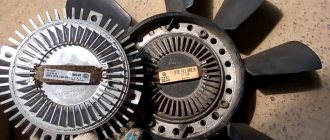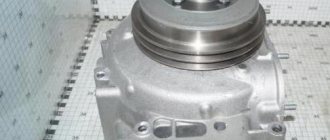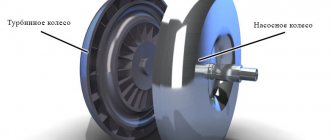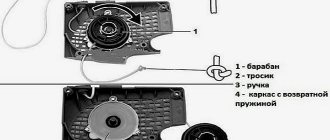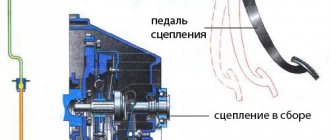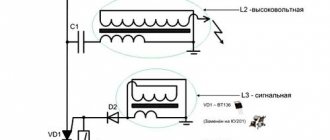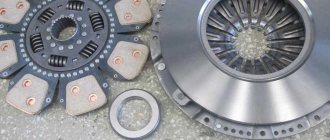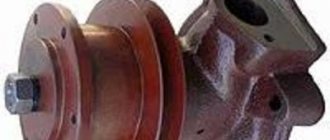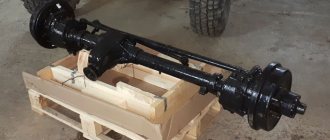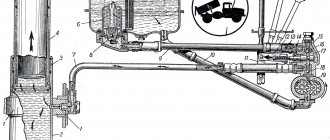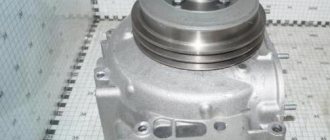The work of many products is based on the use, sometimes in unexpected ways, of a variety of properties of substances familiar to us. An example of this is a viscous coupling - a special device designed for selective transmission of torque, depending on external conditions. For such products, the operating principle is based on changing the viscosity of the liquid poured into it. This is not to say that they are used extremely widely, for example as a manual transmission, but it would be wrong to ignore their use.
Viscous coupling is a viscous coupling, part of a car transmission, a mechanism for transmitting and equalizing torque. Unlike a fluid coupling and a torque converter, a viscous coupling uses a different operating principle. In this device, torque is transmitted not through the dynamic properties of the fluid flow, but using the viscous properties of the fluid filling the internal space of the viscous coupling. Used as an automatic differential lock mechanism.
The operating principle of a viscous cooling fan coupling. Interesting theory
Most drivers are not familiar with the operating principle of the viscous cooling fan coupling. Therefore, if there are problems with this unit, mechanics begin to split hairs and reinvent the wheel. How to fix this part is legendary. Many people fall for them and end up with several more problems. Most often, drivers try to clamp the clutch discs. To achieve a permanent connection between the fan and the shaft. To do this, holes are made in the viscous coupling and bolts are screwed into them. This works for some time, but after 100-200 km of travel they are cut off, which can lead to damage to the radiator. This is due to the structural features of this structural element.
Checking the viscous coupling for functionality
The first symptom of normal operation of the clutch will be its short-term activation when the cold engine is started for the first time.
This is due to the fact that during parking, the liquid flowed into the gap and was not yet thrown into the housing reservoir. Then the characteristic sound of the working impeller blades will disappear, its speed will decrease, although not to zero.
With such an idle speed of the fan, it can even be stopped with any soft object, usually a rolled-up newspaper, rubber hose or plastic bottle is shown. Under no circumstances should you try to do this with your hands.
As the radiator warms up, the valves open and the fan begins to operate at full power. Its speed increases when the gas is released almost immediately behind the engine, but it is no longer possible to stop it. This will be a sign of normal operation of the clutch.
How it works
The operating principle of a viscous cooling fan coupling is directly related to its structure. Thanks to these features, the fan does not operate constantly, but depending on the temperature of the coolant. This allows the cooling system to operate as efficiently as possible. The viscous coupling itself consists of a non-separable oval-shaped body. There are two disks inside it. One of them is rigidly mounted on the fan impeller shaft. The other is mounted on a shaft connected to the drive. The discs are in a viscous silicone liquid, which is also located in a small reservoir. The design also includes a bimetallic plate.
This system works as follows. At normal air temperatures, the discs are either a short distance apart or slightly interlocked. In any case, one slips relative to the other. In this position the fan does not work.
An increase in temperature leads to the fact that the bimetallic plate, compressing, bends, squeezing liquid out of the reservoir. As a result, the pressure on one of the discs increases. It presses against the fan impeller disk and begins to spin it. The higher the temperature, the tighter they are pressed and the less they slip. When the temperature decreases, the plate returns to its original position. The pressure inside the chamber returns to normal and the fan stops.
The viscous coupling is installed together with the fan on the pump shaft. Sometimes this design can be seen on the crankshaft, it all depends on the layout of the given car model. A fan with a viscous coupling is much more efficient than a simple impeller mounted on a shaft. After all, it works as needed, without cooling the engine, for example, when warming up in winter. Most often, fans with viscous couplings are installed on cars that constantly operate under load:
- SUVs;
- Crossovers;
- Sports cars;
- Trucks.
This is due to more efficient cooling in all conditions.
Internal structure of a viscous coupling
Structurally, a viscous coupling (VM) is a sealed housing, usually cylindrical in shape. Inside it are installed round perforated steel discs (with a small gap between them). Half of these plates are connected to the drive (input) shaft, the rest - to the driven (output) shaft. Moreover, the disks have different hole geometries. There are plates with slots installed on the input shaft, and plates with “holes” on the output shaft. The disks inside the case are installed so that they alternate: first one “master”, then one “slave” and so on. Mechanically, both shafts are not connected to each other.
The entire internal volume (and the spaces between the discs) is filled with a special liquid (so-called silicone oil) based on polydimethylsiloxane.
Repair and replacement
Almost all modern cars are equipped with non-separable viscous couplings. Therefore, repair of this unit is impossible. But there are models mainly made in Germany with the ability to replace the bearing and add fluid.
This element has several faults. When a bearing fails, you can hear a characteristic howl from under the hood. If there is a lack of fluid, the fan's efficiency decreases. It begins to spin more slowly, until it stops completely. The same can be observed when disks are damaged.
Parsing
All work begins with removing the fan. It is usually secured with 3 or 4 bolts. By removing it, you can assess the condition of the coupling. If you have a collapsible model, you can try to repair the part. Before removing the bearing, you need to drain the liquid through a special hole. Next, use a screwdriver to remove the plate covering the bearing. And it is pulled out using a special puller. After this, a new spare part is installed.
The new bearing is pressed in using a special mandrel. You cannot do this with a hammer or hit the bearing in any way. This may damage it. A lack of fluid can be determined by the sudden stop of the fan after you turn off the engine. The motor also begins to overheat.
You should add special silicone-based viscous coupling oil. This is done using a special syringe. You can also use a medical one, the largest one you can find. Failure of the discs can only be determined by disassembling the clutch. They cannot be repaired.
Replacing the viscous coupling is not difficult. After removing the assembly from the engine, unscrew the fan impeller. Install a new coupling. At the same time, pay attention to the tightening of the bolts. They must be screwed in properly. After this, the fan is installed in place. In many cases, it is easier to immediately replace the entire viscous coupling without bothering with its repair.
Conclusion
. The cooling system is an important component of any car. At the same time, the efficiency of even the best systems is not maximum. The operating principle of the viscous cooling fan coupling makes this system the most efficient of all those currently in use. Knowing how such a clutch works, you can promptly identify its malfunction.
Selecting a new device
Like selecting any other part for a car, finding a new viscous fan coupling is not difficult. To do this, you can use the services of online stores. Even if the device that this or that store offers is too expensive, you can at least find out the catalog number of the mechanism. This will make it easier to find the product on other platforms. By the way, many online car stores offer both original spare parts and their analogues.
It is best to search for original products by VIN code (read about what information about the car it contains, as well as where to find it in the car, in another article ). Also, in a local auto store, selection can be carried out according to the vehicle data (date of manufacture, model, make, as well as engine characteristics).
An important factor when choosing any device, including a viscous coupling for a cooling system fan, is the manufacturer. When purchasing many auto parts, you should not trust packaging companies, but this does not apply to viscous couplings. The reason is that there are not many companies involved in the manufacture of these products, so in most cases the product will be of the required quality, and the difference between the original and the analogue will be the cost. Such companies usually supply couplings to factories where vehicles are assembled.
The products of the following manufacturers are worthy of attention:
- German companies Behr-Hella, Meyle, Febi and Beru;
- Danish manufacturer Nissens;
- South Korean company Mobis.
The products of Turkish and Polish manufacturers that have recently entered the market deserve special attention. If you have the opportunity to choose another manufacturer, then it is better not to be tempted by the budget price. To determine the reputation of a company, it is enough to pay attention to its product range.
Usually, decent viscous couplings are sold by companies engaged in the production of radiators and other elements of cooling systems for transport. If you have experience in purchasing a high-quality radiator, then you should first look for a suitable viscous coupling in the catalog of this manufacturer.
Viscous cooling fan operation
A viscous coupling, also known as a viscous coupling (from the Latin viscosus - viscous) is a mechanical device that transmits torque using a viscous fluid.
In this video, see what the clutch is in this device
The principle of operation of the viscous coupling is carried out thanks to a belt drive that connects the coupling rotor and the crankshaft pulley of the internal combustion engine. There are also car designs in which the clutch is installed directly on the crankshaft or camshaft.
In order to understand how a viscous coupling works, you need to understand what it consists of.
The device consists of:
- Spring.
- Bimetal plate.
- Inlet port B.
- Inlet channel A.
- Camera.
- Return valve.
- Return valve.
- Rear springs.
- Front reservoir.
- Rotor.
- Device body.
- Rotor shaft.
- Bearing shell.
- Rear reservoir.
- Rear plate.
- Rotor.
- Front plate.
- Lid.
Due to the complex design of the device, the price of a viscous fan coupling is relatively high.
Advantages and disadvantages
First, about the advantages of viscous coupling:
- simplest design;
- durable housing that can withstand pressure up to 20 atmospheres;
- affordable cost due to simplicity of design;
- does not require maintenance and is usually operated without breakdowns throughout the entire service life of the vehicle.
The main disadvantages of viscous coupling:
- impossibility of repair (if the viscous coupling is broken, it is replaced with a new one);
- danger of overheating during prolonged operation;
- there is no possibility of manual blocking;
- incomplete automatic blocking;
- delayed response;
- incompatibility with anti-lock brake system (ABS);
- lack of all-wheel drive control;
- Large couplings greatly reduce ground clearance.
How to check a viscous coupling
The resource of this device in the design of the car is designed to cover 200 thousand km.
To check whether the fan and clutch are working well, you need to know the signs of malfunctions of these parts:
- If the engine heats up quickly, then this is the first sign of a viscous coupling malfunction. This appears due to the release of the gel or the untimely operation of the bimetallic plates. In this situation, when the motor gets very hot, the fan spins at a low speed, or does not turn on at all.
- The cooling fan starts spinning when the engine is still cold. This occurs due to changes in the properties of the gel, hardening of the lubricant and failure of other elements of the viscous coupling.
Reasons for failure or poor performance of a viscous coupling:
- The resource has been exhausted.
- Mechanical damage.
- The bearing has expired or broken prematurely.
- Axial runout of the fan impeller. Part of the propeller blade is broken.
- Lack of lubrication of the coupling shaft.
- Contamination of the coupling connection.
Advantages and disadvantages of a fan driven via a viscous coupling:
The advantage of a viscous coupling is that there is no electronics or electricity involved.
- The viscous coupling provides more power, the fan rotates at a higher speed. If the clutch sits rigidly on the crankshaft of the internal combustion engine, then the rotation speed is very high.
The power of the clutch connected to the crankshaft is several kW (kilowatts). And the power of electric fans has a power of several tens of watts. Thanks to this, a fan with a viscous coupling is used in agricultural machinery, military equipment, and special equipment.
Disadvantages of viscous coupling:
- Complex design, more difficult to repair. It is cheaper to buy a new assembly assembly.
- Has good mass. The weight on the internal combustion engine crankshaft is significant.
- Switching on temperature control is not entirely correct. There are errors in turning the cooling fan on and off.
- At high speeds there is an increased noise level.
- According to the schedule, you have to refill with gel or oil with the required viscosity.
- The viscous coupling partially takes away the engine power.
This list of shortcomings of viscous couplings influenced the decisions of the owners of automakers. They refused to use such devices in passenger cars.
Design and basic operation of automotive viscous couplings
By design, a viscous coupling is a block of thin disks, which are assembled into a package and mounted in a hermetically sealed housing. Structurally, the coupling consists of two packages, one of which is the drive, the second is the driven, respectively, they are connected to the input and output shafts.
The surface of the disks that make up the bags is specially perforated with holes and stamped with bulges. Each of the disk blocks is assembled in such a way that there is a minimum permissible distance between the individual disks that make them up.
The cavity of the viscous coupling fan housing on a car is filled with dilatant liquid. Most often, it is based on a viscous substance of silicon-organic origin (silicon), which has an unstable viscosity that increases sharply as a result of an increase in the rate of displacement deformation.
An increase in the efficiency of the clutch is also facilitated by the property of the liquid to expand very strongly when the temperature rises, which leads to the emergence of additional pressure force from the liquid transmitted to the discs. Due to the listed features of the viscous coupling, the disks seem to stick together when the rotation speed increases.
If the movement of the car is uniform, then the rotation speed of the drive and fluid-driven shafts is the same and does not increase, because The internal resistance in the liquid is stable. If one of these two shafts changes its rotational speed relative to the other, the discs in the vehicle's viscous coupling are subject to intense relative displacement.
As a consequence, there is an abrupt increase in the viscosity of the liquid and the tendency of the emerging intrafluid friction force to equalize the angular velocities of both disk packages. A significant difference in viscous coupling speeds leads to the liquid hardening due to a significant increase in its own viscosity. In this case, the clutch self-locks and begins to transmit torque from the drive shaft to the driven shaft without actual loss.
DIY viscous coupling repair
If this device stops working, you must first refill it with gel or special oil.
There are not many specialists who can repair viscous couplings. Sometimes it is cheaper and faster to buy a new device or switch to an electric fan.
To install an electric engine cooling fan, you need the following parts:
- The fan itself is electrically driven.
- Wires with a cross-sectional area of 6 mm2.
- 40 Amp fuse.
- Relay regulator 30 Amp or more.
- A thermal relay, for example, from a Lada car, which is activated when the engine heats up to 87 degrees.
The thermal relay can be glued to the radiator or next to the thermostat on a metal surface.
After this, you need to make a connection diagram, like on VAZ cars. The VAZ electrical circuit for connecting the fan will last about 5 years.
How repairs are made
So, when the driver notices that the car’s engine has begun to overheat more often, and other parts of the cooling system are working properly, the viscous coupling should be diagnosed (the procedure is described a little higher). As we have discussed, one of the device failures is a leak of silicone substance. Although the user manual states that this fluid is poured into the mechanism once at the factory, and it cannot be replaced, the motorist can independently replenish the volume lost as a result of depressurization or replace the fluid with a fresh one. The procedure itself is simple. It is much more difficult to find the right working substance.
In stores, these products are sold under the following names:
- Viscous coupling repair fluid;
- Oil to viscous coupling;
- Silicone substance for viscous couplings.
The repair of the viscous coupling, which is used in the all-wheel drive system, deserves special attention. In this case, it is recommended to select a new liquid in accordance with what type of substance was used before. Otherwise, after repair, the transmission will not connect the second axis or will not work correctly.
To repair the viscous coupling, which is used in the cooling fan drive, you can use a universal analogue. The reason is that the torque transmitted through the disks of the mechanism is not as great as in the transmission (more precisely, such a large power take-off is not required in this case). The viscosity of this material is often sufficient for the mechanism to operate.
Before you begin repairing the coupling, you need to check how much silicone fluid is in the device. Each fan model may use a different volume of substance, so information about the required level should be found in the user manual.
To add or replace fluid in the clutch, you must:
- Remove the mechanism from the car and remove the impeller from the coupling;
- Next, you need to lay the product horizontally;
- The pin installed behind the spring-loaded plate is removed;
- There must be a drain hole in the coupling housing. If it is not there, then you will need to drill it out yourself, but it is better to entrust this procedure to a specialist so that the disks are not damaged;
- After these procedures, about 15 ml of liquid is pumped inside through the drain hole using a syringe. The entire volume must be divided into several portions. During the pouring process, you need to wait about a minute to a minute and a half so that the viscous substance is distributed in the gaps of the disks;
- The mechanism is being reassembled. To keep the device clean, you need to wipe it, removing any remaining silicone substance from the surface, which will contribute to accelerated contamination of the case.
When the driver hears noise coming from the fan while rotating, this indicates bearing wear. Replacing this part is carried out according to the same procedure as filling the liquid, with the exception of several additional manipulations. The liquid itself must be replaced with fresh one.
To remove the bearing from the housing, you must use a bearing puller. Before doing this, it is necessary to remove the flaring along the edge of the mechanism housing (it prevents the bearing from falling out of the seat). It is not recommended to dismantle the bearing using any improvised means, since in this case damage to the contact surfaces and disks cannot be avoided. Next, a new bearing is pressed in (for this you need to use the option with a closed socket with the appropriate dimensions).
In no case should the repair process be accompanied by great efforts on one of the shafts of the device. The reason is that even a slight deformation of one of the disks is enough, and the coupling will be unsuitable for further use. During the repair process, you may notice that there is a thin film of lubricant on the device. It should not be removed.
As practice shows, most motorists who decide to repair the viscous fan coupling themselves encounter difficulties associated with assembling the mechanism. In order not to confuse what is connected where, it is better to capture each stage of disassembly on a camera. Thanks to this, step-by-step instructions for reassembling the device will be available.
As mentioned a little earlier, instead of a fan with a viscous coupling, you can install an electric analogue. To do this you will need:
- Buy a fan of suitable size with an electric motor (often these cooling system components are sold already mounted on a radiator);
- Electrical cable (minimum core cross-section must be 6 square millimeters). The length of the wiring depends on the size of the engine compartment. It is not recommended to lay wiring directly or near vibrating and sharp elements;
- 40 amp fuse;
- Relay for turning the fan on/off (the minimum current with which the device can operate must be 30A);
- Thermal relay that operates at a temperature of 87 degrees.
The thermal relay is installed on the radiator inlet pipe or you need to glue it to the metal part of the pipeline, as close as possible to the thermostat. The electrical circuit is assembled according to an analogue of VAZ models (the diagram can be downloaded from the Internet).
How to disassemble the coupling
- First of all, remove the cooling fan. As a rule, to remove it you need to unscrew 3 or 4 bolts.
- We inspect the coupling.
- Let's dismantle it.
If the coupling is dismountable, then you can repair it:
- To do this, first drain the oil through a special hole.
- Remove the plate that covers the bearing.
- The bearing is removed with a puller. You can make a puller with your own hands, or you can buy one.
- Press in a new bearing.
- They put on a record.
- Pour in gel or oil.
- Attach the fan.
How can you tell if there is enough fluid in the viscous coupling? If, when the engine is stopped, the fan stops abruptly, then there is not enough liquid.
It is recommended to fill the viscous coupling with silicone-based oil. Refilling is done with a syringe.
If there are mechanical failures, then it is not repaired.
Replacing the old one and installing a new viscous coupling is an easy job, even a beginner can do it. After dismantling the device, you need to remove the fan impeller. Install a new coupling. When installing a new coupling, you must tighten the bolts firmly, but without stripping the threads. Then you need to install the fan in place.
About the liquid inside
At the very beginning, I would like to talk about the liquid that is inside the viscous coupling, what it is and what properties it has.
To begin with, I would like to say that what is poured inside is a dilatant liquid, which is based on silicone. Its properties are very interesting: unless it is heated or stirred too much, it remains liquid. BUT if you mix it strongly and heat it a little, it thickens and expands very much, becoming more like frozen glue. After mixing again becomes insignificant, it again acquires its original state of aggregation, that is, it becomes liquid.
It is worth noting that the liquid is filled for the entire service life of this unit and cannot be replaced.
What is a viscous coupling: principle of operation, types and repair
An article about viscous coupling - what it is, functions, pros and cons, types, repairs. At the end of the article there is a video on how to check and repair a viscous coupling.
Any car is a complex structure consisting of many units and components. Over time, they begin to age and cease to cope with basic tasks, which forces vehicle owners to send the car for repairs.
As an example, we can take a viscous fan coupling, which is designed for selective transmission and directly affects the torque
. And in order to prevent possible damage to the unit, as well as to know what actions to take in the event of an unexpected breakdown, you need to carefully study the principle of operation of the viscous coupling, its design features and a number of other points.
Functionality check
Checking the viscous fan coupling is not difficult. According to the vehicle operating instructions, this must be done first on a cold internal combustion engine, and then after it reaches operating temperature. Here's how the mechanism works in these modes:
- Cold system . The engine is running, the driver briefly increases the engine speed several times. A working device will not transmit torque to the impeller, since the outlet must remain open and there is no interlocking between the discs.
- Hot system . In this case, depending on the temperature of the antifreeze, the shutoff of the drain circuit will depend, and the fan will rotate slightly. The revs should increase when the driver presses the gas pedal. At this moment, the engine temperature rises, the pump drives hot antifreeze along the line to the radiator, and the bimetallic plate is deformed, blocking the drainage of the working fluid.
The mechanism can be checked independently without diagnostics at a service station in the following ways:
- The motor doesn't work. Try to rotate the fan blades. There should be some resistance felt. The fan should not rotate by inertia;
- The engine starts. A slight noise should be heard inside the mechanism for the first few seconds, which gradually subsides due to some filling of the cavity with the working fluid.
- After the engine has been running for a while, but has not yet reached operating temperature (the thermostat is not open), the blades will rotate slightly. We roll a sheet of paper into a tube and insert it into the impeller. The fan should lock, but there should be some resistance.
- The next step involves dismantling the coupling. The device is immersed in boiling water to heat up its internal parts. An attempt to rotate the blades should be accompanied by resistance from the mechanism. If this does not happen, it means that there is not enough viscous substance in the coupling. During this work, you can additionally dismantle the heat exchanger of the cooling system and wash it.
- Check for longitudinal play. In a working mechanism, this effect should not occur, since a constant gap must be maintained between the disks. Otherwise, the mechanism needs to be repaired or replaced.
There is no need to carry out further inspection if at any stage a malfunction of the fan is detected. Regardless of whether the clutch needs to be repaired or not, there is always a need to service the cooling system at the end of the summer season. To do this, the heat exchanger is removed and any contamination in the form of fluff, leaves, etc. is removed from its surface.
Symptoms of a problem
Since the fan in the engine compartment is designed to forcibly cool the engine during operation, overheating of the power unit is one of the main signs of a clutch malfunction. It is worth noting that this is also a symptom of failure of other elements included in the cooling system, for example, the thermostat.
The motor will overheat due to the fact that a leak has formed in the coupling, and the fluid either poorly transmits rotational forces between the disks or does not provide this connection at all. Also, such a problem can occur as a result of untimely operation of the bimetallic plate.
When the clutch does not operate properly, the impeller stops rotating or performs its function with minimal efficiency, no additional cool air flow is supplied to the heat exchanger, and the motor temperature quickly rises to a critical value. If the car is in motion, the radiator is blown efficiently, and forced airflow is not required, but when the car stops, the engine compartment is poorly ventilated, and all mechanisms and assemblies are heated.
Another sign of problems with the viscous coupling can be identified by starting a cold engine and observing how the fan behaves. When the unit is not warmed up, this mechanism should not rotate. the opposite effect is observed when the working substance loses its properties, for example, it hardens. Due to longitudinal play, the discs can be in constant contact with each other, which also leads to constant rotation of the blades.
Main causes of malfunction
The key reason for problems with the operation of a viscous coupling is the natural wear of the mechanism parts. Therefore, each manufacturer establishes certain regulations for the scheduled maintenance of vehicle mechanisms. The minimum working life is from 200 thousand kilometers of vehicle mileage. On the secondary market, a car with a viscous fan coupling will always have decent mileage (you can read about how to determine whether the mileage on a used car is twisted in another article ), so there is a high probability that you will need to pay attention to the mechanism in question.
Here are some other reasons for viscous coupling failure:
- Deformation of the bimetallic plate due to frequent heating/cooling;
- Bearing failure due to natural wear;
- Broken impeller blade. Because of this, runout is formed, which accelerates bearing wear;
- Depressurization of the housing, which causes leakage of the working substance;
- Loss of liquid properties;
- Other mechanical failures.
If the driver does not monitor the cleanliness of the mechanism or heat exchanger, then this is another reason for the failure of the device.
The moment of activation of the mechanism must be monitored at least once a month, especially in summer, since during hot periods the motor especially needs cooling. Even if the new viscous coupling does not do its job well, there may be a reason to install an electric, more powerful analogue. By the way, some motorists install an electric fan as an auxiliary element for greater effect.
General information about viscous coupling
One of the most important components of a car is a rotating viscous coupling, inside of which there are alternating perforated plates with a viscous liquid. There are many types of such structures on sale with different operating properties and features, but the general principle of their operation remains the same.
This part differs from a fluid coupling and a torque converter in its specific operating principle. First of all, another method of transmitting torque is involved here, which is based on the influence of a special viscous fluid located in the internal space of the structure.
The first mention of viscous coupling appeared in 1917
, but in those days it failed to become widespread, because did not have many of the current advantages. Only in 1964 the product was significantly improved and began to be put on mass sale. In the 60s of the last century, these inventions began to appear in cross-axle differentials on all-wheel drive passenger cars.
Using viscous couplings for wheels of one axle.
Another option for using the coupling is possible - for wheels of the same axle. In this application, the device is installed between the axle differential and the axle shaft. In this case, when cornering or one of the wheels slips, the device helps to redistribute the torque between them, ensuring safe maneuvering or passing through a problem area.
There are solutions in which a pair of parts are placed on the wheels of one axle. This design allows you to abandon the axial (cross-wheel) differential. At the same time, the use of a pair of viscous couplings makes it possible to provide all modes - both differential rotation and blocking of the axle wheels.
Operating principle and purpose
To understand the operating principle of a viscous coupling, you need to carefully familiarize yourself with its design. All its parts are fixed in one sealed housing, which contains two rows of disks connected by a driven and drive shaft. Each row is equipped with holes and protrusions with a small distance from each other. A high-viscosity liquid consisting of silicone additives flows inside the viscous coupling. It is characterized by a special composition that allows it to effectively service the drive system and provide the required torque.
Types of viscous couplings
On the automotive spare parts market you can find two main types of viscous couplings:
- The first type is characterized by a constant volume of amateurish liquid.
- The second type has a different volume of silicone, which changes depending on external influences.
The first type of viscous coupling is used for limited slip differentials in transmissions, including automatic all-wheel drive systems. They are used in internal cooling systems.
If the part operates in normal mode with average loads, and the car moves on a high-quality road surface, the angular velocities of the two axes remain the same.
The rotation of the clutch discs is almost uniform, and torque is transmitted from the engine to the driven axle with minimal load. As a result, the vehicle can operate in both all-wheel drive and rear-wheel drive.
But if the car gets into rough terrain or drives on ice and mud, the uniformity of rotation is seriously reduced, and the viscosity of the silicone increases significantly. This increases the transmission of torque to the second axle. In some cases, the power transfer rate reaches 100 percent.
At the same time, the viscous coupling cannot replace a full-fledged differential, which redistributes the torque of the power plant to both axles. It is advisable to use this design on uneven surfaces and rough terrain. It will also be justified when driving:
- on ice;
- city streets;
- wet track.
If driving is carried out completely off-road, the clutch should engage instantly. otherwise, the torque transmission system will fail, resulting in the need for expensive and complex repairs.
In most modern cars with automatic transmissions, viscous couplings operate in the so-called “pre-start mode”. It is characterized by a uniform transfer of 5-15% of the motor power to the driven axle, which negatively affects the reaction time of the unit.
Design and principle of operation
The operating principle of a viscous coupling is based on the transmission of rotation using the viscous properties of the fluid. This makes a viscous coupling fundamentally different from, for example, a torque converter, which uses the movement of fluid, that is, its dynamic properties.
Viscous coupling device diagram
A viscous coupling is a housing with a pack of disks inside. The disks are rigidly connected to the shafts and are placed alternately: one disk of the first shaft, the second - of the second, the third - again of the first, etc. The distances between the disks are minimal. This entire structure is filled with a special silicone-based liquid, which has an interesting property: with active stirring or heating, it becomes more viscous. With very fast movement, when the force of hydrodynamic resistance increases, it acquires the properties of a solid body; when it slows down, it immediately becomes more liquid. The principle of operation is clearly shown in the video below.
The viscous coupling process looks something like this:
- The car is driving on a flat, good road. Both axes rotate at the same speed. Inside the viscous coupling, packages of disks, mounted alternately on one and the second shaft, also rotate at the same speed, without rotating relative to each other. In this case, the viscous coupling is “turned off”, that is, the torque from the drive axle is not transmitted through it to the driven one (with the exception of approximately 12-15%, which will flow to the second axis due to the viscosity of the working fluid);
- The wheels on the leading axle begin to slip, but on the second axle they stop or almost stop. In this case, the plates of one shaft stand still, and the second one rotates very quickly. In this “blender” the liquid begins to move, heats up and thickens. The thickened liquid interlocks the plates of the two shafts with each other, and the greater the difference in their speed, the faster this happens;
- When the clutch is activated, the torque from the drive axle (which is slipping and spinning quickly) is transferred to the driven axle, and its wheels begin to move. If necessary, almost 100% of the torque is supplied to the driven axle, that is, the drive changes;
- When driving onto a normal road, the rotation of the plates in the clutch relative to each other stops, the fluid becomes less viscous, and the all-wheel drive is turned off.
The viscous coupling operates quickly but gently: 0.2 seconds is enough to completely block one axle. In this case, no jerks occur, and the device does not put extra stress on the transmission.
Areas of application of viscous coupling
Previously, there were two areas of application for viscous couplings, but today their number has been reduced to one. In the recent past, a similar mechanism was intended for comprehensive engine cooling, which was possible by attaching a special viscous coupling with a ventilation device to the rod. Its movement is determined by the crankshaft of the car, to which the belt is laid. Depending on the engine rotation speed, the liquid acquires different thicknesses and receives a rigid connection with the fan.
When the speed decreased, no strong mixing occurred, i.e. if slippage was present, the cooling process of the system was not good enough. It is advisable to use the product as a full-fledged element of the cooling system only in the cold winter season, when the engine is not very warm and needs to provide additional cooling.
A more popular application is to provide automatic connection to an all-wheel drive system.
In this area, viscous couplings are extremely relevant, because most SUVs, crossovers and SUVs are equipped with such units. Even the rapid growth in popularity of advanced electromechanical options does not spoil the great popularity of viscous couplings.
The product is in great demand due to the following advantages:
- affordable price;
- practical application;
- versatility.
However, in addition to the advantages, viscous couplings also have disadvantages.
Where are viscous couplings used?
There are actually only two main applications, but now there is only one left:
- Used to cool the engine. A viscous coupling with a fan was attached to the rod. It was driven by the crankshaft of the car via a belt drive. The faster the engine rotated, the thicker the liquid became and the connection with the fan became tighter. If the revolutions dropped, then such strong mixing did not occur, which means there were slippages, that is, the fan rotated and did not cool the radiator as much. Such a system is effective for the cold (winter) period, when the engine does not warm up much, but is also cooled. Nowadays, the use of such systems on new cars is no longer seen; it has been replaced by electronic fans (with sensors in the liquid), which are powered by electricity and are in no way connected to the engine crankshaft.
- Automatic all-wheel drive connection. It is in this direction that viscous couplings remain very much in demand. Almost 70 - 80% of crossovers or SUVs now use such systems. True, they are gradually beginning to be replaced by fully electromechanical options, but for now they are more expensive and not so practical.
On the one hand, a viscous coupling is a very simple, cheap, practical and universal mechanical device, on the other hand, it has quite a lot of disadvantages.
Disadvantages of viscous coupling
One of the most significant disadvantages of a viscous coupling is its “disposability”. In most cases, the part cannot be repaired, and the repair work itself requires a lot of effort and financial investment, so motorists are considering the option of purchasing a new part.
In addition, the drive cannot be connected manually, and its efficiency is quite low.
Maximum torque is transmitted only under heavy braking.
Most viscous coupling models are small in size, so when located at the bottom of the system, there is a limitation in the transmission of torque to the rear axle.
Such a device is not able to work for a long time and withstand impressive loads
. Otherwise, it will quickly deform and become unsuitable for further use. Prolonged driving on off-road, mud or ice will cause the viscous coupling to fail and need to be replaced.
What is it used for?
In modern cars, viscous couplings are used for:
- temporary transfer to all-wheel drive mode (AWD);
- center differential locks.
Let's look at these points in more detail.
Switching the vehicle to AWD mode
Many modern crossovers or SUVs, as well as some minivans, sedans or hatchbacks, are equipped with so-called temporary all-wheel drive. The differential axis of the drive (usually the front) axle is connected through a viscous coupling to a similar unit of the rear wheels. Under normal conditions, both shafts rotate at the same speed. The viscosity of the silicone fluid does not change, and, therefore, no transmission of torque to the rear axle occurs. As soon as the front wheels begin to slip, the viscous coupling comes into operation. The vehicle then returns to standard front-wheel drive mode.
On a note! For vehicles equipped with temporarily connected all-wheel drive via a viscous coupling, the diameter of the front and rear wheels must be the same. This will allow you to avoid false alarms of the VM (for example, when driving on the highway). If you install the driving front wheels of a smaller diameter (in this case they will make more revolutions per minute than the rear ones), then at certain speeds the viscous coupling may “think” that they are slipping and engage all-wheel drive at the most inopportune moment.
Inside the viscous coupling there is a dilatant liquid (DL), the viscosity of which increases significantly as the intensity of its mixing accelerates. If the speed of the vehicle is stable (when the car is not slipping), then the fluid has a liquid consistency and the plates rotate equally (parallel to each other). Only minimal mixing of the liquid is observed. As a result of slipping, the drive shaft begins to rotate very quickly (and therefore the plates on it), and the driven shaft practically remains without any movement. Next, very intense mixing of the liquid occurs, causing a sharp increase in its viscosity. Heating of the liquid and its expansion are also observed, as a result of which the plates begin to press quite strongly against each other (they practically “stick” together). Part of the torque is transferred from the drive shaft to the driven shaft, the car stops slipping, the rotation speed of both shafts stabilizes, the viscosity of the fluid decreases significantly, its mixing stops and the rear axle is switched off. That is, “everything returns to normal.”
Center differential lock
One of the integral components of the transmission is the differential. It is designed so that when turning, the wheels can rotate at different angular speeds, since they (right and left) travel different lengths when performing such a maneuver. Some vehicles are equipped with a differential lock using a viscous coupling integrated into it. This function is very useful if one of the drive wheels (for example, hitting a wet or slippery section of the road surface) begins to slip. In this case, the VM blocks the differential. The same torque is transmitted to both wheels. After the “problem” section of the road is overcome, the viscous coupling disks “disconnect” and the differential goes into normal operation.
On a note! On SUVs (for example, Subaru Forester or BMW 325ix E30) equipped with a permanent all-wheel drive system, the VM “works” when one of the drive axles slips. Technologically, it is integrated into the central differential and blocks it to equalize the rotation speed of the front and rear shafts.
How to repair a viscous coupling
If the engine begins to overheat and make a lot of noise when running at high speeds, there is no need to rush to replace the viscous coupling. If you approach this problem correctly, it can be eliminated with little effort. Often, failure occurs when oil leaks from the base of the structure, which requires refilling the silicone. To solve the problem, you need to carefully remove the part from the pump, and then disassemble it. The round disk of the element must have a plate with a spring, under which there is a hole for the oil base.
To prevent product failure, care must be taken when removing the pin.
Then you should start adding lubricant, for which it is better to use a syringe. It is important to note that when performing such a task, it is better to place the viscous coupling horizontally. Using a syringe, you can take 15-20 ml of liquid and slowly place it inside.
After a few minutes, the silicone should penetrate tightly into the viscous coupling and become fairly solid. Ultimately, you need to clean the surface of the structure from excess silicone and re-install the part.
Another common cause of viscous coupling damage is bearing deformation. The first symptom of such a malfunction is intense noise. To repair the product, it must be dismantled by unscrewing the three fixing bolts. In this case, the structure can be easily detached from the engine compartment. After removing the coupling and draining the silicone, you can begin the bearing replacement procedure.
There are no particular difficulties in solving this problem, but to simplify the task, it is recommended to use a special puller. There is such a tool in every garage. If you use improvised means, you can completely damage the unit and cause yourself additional trouble in the form of expensive repairs. Having completed the installation of the new bearing, all that remains is to reassemble the part and start the engine.
Also, when performing repairs, you cannot forget about pouring new silicone, which was drained before the repair.
If the coupling “behaves incorrectly,” there is no need to rush to buy a new product, because perhaps the problem lies in a minor breakdown, which can be quickly solved with your own hands. And for this you do not need to have special skills and abilities.
The only problem with repairs is the difficulty of finding a tool to remove the old bearing. If you don’t have it in your garage, you can borrow it from friends or purchase it from a car repair shop. Other parts and consumables are available at all automotive stores.
Role in the internal combustion engine cooling system
A viscous coupling fan is installed on vehicles with a longitudinal engine (usually all-wheel drive and rear-wheel drive models). With this arrangement, it is most advisable to connect the radiator fan pulley to the water pump pulley. As you know, rotation of the water pump is transmitted by a service belt from the crankshaft pulley.
The disadvantage of this design is that the rotation speed of the fan impeller will always be proportional to the crankshaft speed. Such a device will result in the engine being excessively cooled at high speeds in cold air conditions, which will reduce its efficiency. In addition, the permanent connection of the impeller and the crankshaft pulley will increase mechanical friction losses, which will take away power and increase fuel consumption.
The viscous fan coupling allows you to adjust the rotation speed of the impeller depending on the engine temperature.
Device
The difference in the design of viscous fan couplings for Toyota, BMW, Mercedes, Audi. is minimal, since they are all designed and work according to the same principle.
A shaft with a connecting flange is attached to the cooling pump drive, so its rotation speed is always proportional to the crankshaft speed. A drive pulley, in turn, is attached to the shaft, which rotates in the working chamber. The working and backup chambers are separated by plates. The transition between chambers is only possible through inlet valves and return passages. Initially, the backup chamber is filled with special silicone oil. The drive pulley, or disk, as it is also called, has oblique teeth around its circumference, which, when rotated, allow the oil to be expelled back into the reserve chamber. The surface of the drive disks, like the dividing plates, has special ribs that turn the working chamber into a kind of network of labyrinths through which silicone oil circulates.
The coupling housing, to which the fan impeller is attached, is connected to the shaft (viscous coupling rotor) via a conventional ball bearing. The inlet valves are connected to a bimetallic plate, which is located in front of the viscous coupling housing. When heated, the plate expands, which leads to an increase in the flow area of the valves.
Chronicle of the creation of viscous couplings
People didn’t know what a viscous coupling was until 1917, when in the USA, Melvin Severn invented this very viscous coupling. However, immediately after this it did not find any widespread use. It was only in 1964 that it was first mounted on a car called the Interceptor FF. Developed by engineers of the English company Jensen, it was intended to serve as an automatic locking of the vehicle's center differential.
It was the mid-sixties of the last century that turned out to be the time when viscous couplings began to be widely introduced into the design of all-wheel drive transmissions of passenger cars with permanent drive. Now viscous couplings are installed on Cummins engines, and are also widely used on other engines.
